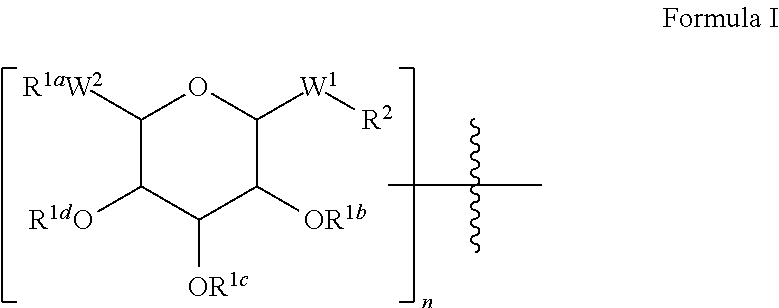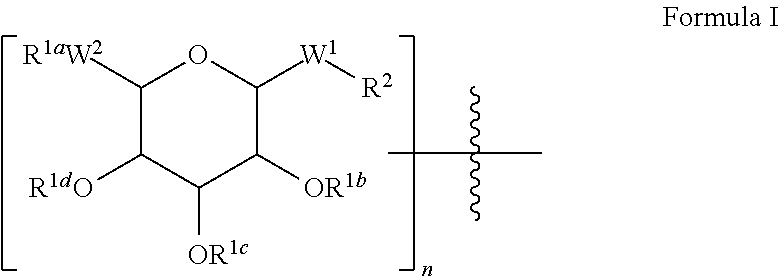Peptide pharmaceuticals for insulin resistance
a technology of peptides and pharmaceuticals, applied in the field of peptide pharmaceuticals for insulin resistance, can solve the problems of peptides and/or protein pharmaceuticals that suffer from several limitations in their use in medicine, peptides and/or proteins are unstable in formulations, and are subject to aggregation, so as to reduce or eliminate the immunogenicity of peptide and/or protein drugs
- Summary
- Abstract
- Description
- Claims
- Application Information
AI Technical Summary
Benefits of technology
Problems solved by technology
Method used
Image
Examples
example 1
Reagents—N-α-Fmoc, N-ε-(1-octyl β-D-glucuronide-6-yl)-L-lysine
[0586]In an oven-dried 250 mL Erlenmeyer flask is placed 1-octyl f3-D-glucuronic acid (Carbosynth Ltd., 3.06 g, 10 mmol), 50 mL anhydrous DMF, and anhydrous 1-hydroxybenzotriazole (1.62 g, 12 mmol). A chilled (4° C.) solution of N,N′-dicyclohexylcarbodiimide (2.48 g, 12 mmol) in 50 mL of DMF is added, with stirring, and the reaction is allowed to proceed for 5 min. The copious white precipitate of N, N′-dicyclohexylurea is filtered on a fritted glass funnel and the filtrate is added to a solution of N-α-Fmoc-L-lysine (3.68 g, 10 mmol) in 25 ml anhydrous DMF. The reaction is allowed to proceed for 25 min with warming to room temp or until the ninhydrin color is very faint. The reaction mixture is filtered, stripped to dryness and crystallized from MeOH / Et2O by dissolution in MeOH and slow dilution to the cloud point with Et2O, followed by refrigeration. Further purification can be achieved by silica gel chromatography usin...
example 2
Synthetic Peptide Analogs
[0589]In general, peptide synthesis methods involve the sequential addition of protected amino acids to a growing peptide chain. Normally, either the amino or carboxyl group of the first amino acid and any reactive side chain group are protected. This protected amino acid is then either attached to an inert solid support, or utilized in solution, and the next amino acid in the sequence, also suitably protected, is added under conditions amenable to formation of the amide linkage. After all the desired amino acids have been linked in the proper sequence, protecting groups and any solid support are removed to afford the crude peptide. The peptide is desalted and purified chromatographically.
[0590]A preferred method of preparing the analogs of the physiologically active truncated peptides, having fewer than about fifty amino acids, involves solid phase peptide synthesis. In this method the α-amino (Na) functions and any reactive side chains are protected by aci...
example 3
General Oxidation Method for Uronic Acids
[0603]To a solution of 1-dodecyl β-D-glucopyranoside (Carbosynth) [2.0 g, 5.74 mmol] in 20 mL of acetonitrile and 20 mL of DI water was added (diacetoxyiodo)benzene (Fluka) [4.4 g, 13.7 mmol] and TEMPO (SigmaAldrich) [0.180 g, 1.15 mmol]. The resulting mixture was stirred at room temperature for 20 h. The reaction mixture was diluted with water and lyophilized to dryness to give 1.52 g (crude yield 73.1%) of the crude product, 1-dodecyl β-D-glucuronic acid, as a white powder, which was used directly for the solid phase synthesis without further purification. This product was previously prepared by an alternative process using NaOCl as oxidant, as described in the specification, and also has been used for longer alkyl groups. In a similar manner are prepared the desired alkyl saccharide uronic acids used to make the products and reagents described herein.
[0604]In a like manner, but using the corresponding 1-tetradecyl, 1-hexadecyl, and 1-octad...
PUM
| Property | Measurement | Unit |
|---|---|---|
| Fraction | aaaaa | aaaaa |
| Mass | aaaaa | aaaaa |
| Electrical resistance | aaaaa | aaaaa |
Abstract
Description
Claims
Application Information
 Login to view more
Login to view more - R&D Engineer
- R&D Manager
- IP Professional
- Industry Leading Data Capabilities
- Powerful AI technology
- Patent DNA Extraction
Browse by: Latest US Patents, China's latest patents, Technical Efficacy Thesaurus, Application Domain, Technology Topic.
© 2024 PatSnap. All rights reserved.Legal|Privacy policy|Modern Slavery Act Transparency Statement|Sitemap



